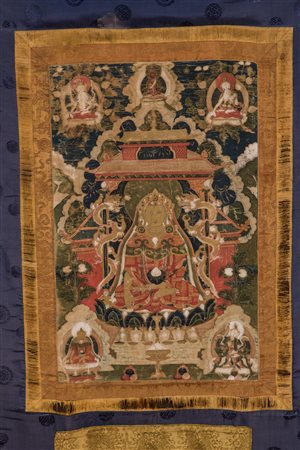 Capitolium Art - Via Carlo Cattaneo 55, 25121 Brescia
Capitolium Art - Via Carlo Cattaneo 55, 25121 Brescia
ASTA 217 - FINE CHINESE, ISLAMIC & ASIAN ART 2A TORNATA
giovedì 15 giugno 2017 ore 14:00 (UTC +01:00)
Arte Himalayana Thangka raffigurante Buddha Shakyamuni Tibet, XIX secolo . -....
Arte Himalayana Thangka raffigurante Buddha Shakyamuni
Tibet, XIX secolo . -. Cm 38,00 x 60,00. Tempera su cotone raffigurante il Buddha storico in una rara rappresentazione. Ritratto all'interno di una pagoda con colonne avvolte da due draghi, è seduto in posizione padmasana su un trono a fiore di loto ed ha la mano sinistra adagiata in grembo a sorreggere la ciotola delle offerte, in posizione avakasamudra, e la destra in bhumisparsamudra.
La peculiarità di questa rappresentazione risiede nella ricca corona che abbellisce il personaggio principale ed una tunica decorata a patchwork e pigmenti dorati. Sullo sfondo è possibile notare un paesaggio verdeggiante che ospita altri cinque personaggi secondari, tra i quali si distinguono, nell'ordine superiore, Usnisavijaya, il Buddha Trascendente Amitayus e Tara Bianca.
Lunga iscrizione in Newari sul retro che fornisce indicazione sulla provenienza da una famiglia Newari residente in Tibet. L'iscrizione riporta anche una data, 1850, che colloca l'opera a metà del XIX secolo o prima.
Pubblicato in Erberto Lo Bue, Tibet, Dimora degli dèi, La Rinascente, Milano 1991, p. 35, n. 5, e Immagini di fede nel mondo tibetano e himalayano, Florence Number Nine, Firenze 2014, p. 25
Provenienza: collezione privata del Prof. Erberto Lo Bue
Arte Himalayana A thangka depicting Buddha Shakyamuni
Tibet, 19th century . . Cm 38,00 x 60,00. Tempera painting on cotton portraying the historical Buddha in an uncommon way. The character is portrayed in a pagoda, with dragons wrapped on the pillars. He is sitting in the padmasana position on a throne shaped like a lotus flower, and holds in the left hand, resting in the avakasamudra, the bowl for the offerings, while the right hand performs the bhumisparsamudra. The peculiarity of the representation lies in the rich crown adorning the main character, together with a patchwork and golden robe. Behind him is a lush background on which five secondary characters are visible, among them, in the upper layer, are Usnisavijaya, the transcendent Buddha Amitayus and White Tara.
On the reverse is a long inscription in Newari, giving information about the provenance from a Newari family living in Tibet. The inscription also bears a date, 1850, placing the work at, or before, the first half of the XIX century. Published in Erberto Lo Bue, Tibet, Dimora degli dèi, La Rinascente, Milano 1991, p. 35, n. 5 and Immagini di fede nel mondo tibetano e himalayano, Florence Number Nine, Firenze 2014, p. 25.
Provenance: private collection of Prof. Erberto Lo Bue.








